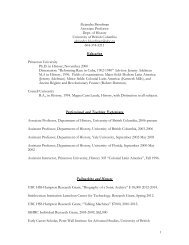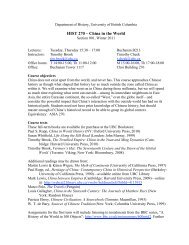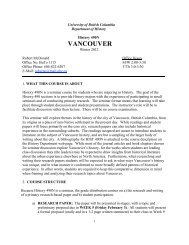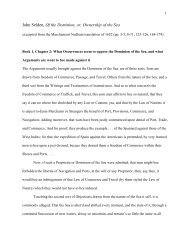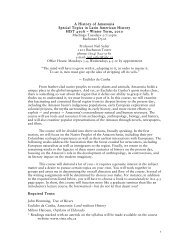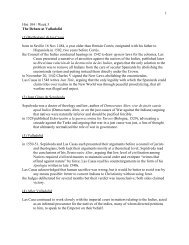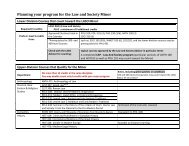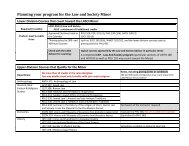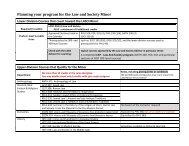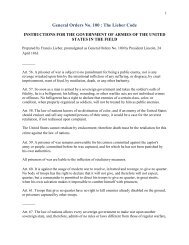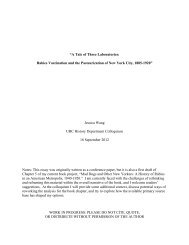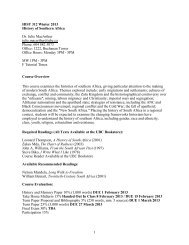Orientalizing the Pacific Rim: - History, Department of
Orientalizing the Pacific Rim: - History, Department of
Orientalizing the Pacific Rim: - History, Department of
Create successful ePaper yourself
Turn your PDF publications into a flip-book with our unique Google optimized e-Paper software.
United States between 1923 and 1926, and continuing through <strong>the</strong> formation <strong>of</strong> <strong>the</strong><br />
Institute <strong>of</strong> <strong>Pacific</strong> Relations in 1926, a network <strong>of</strong> American missionaries and social<br />
scientists criss-crossed Asia, America, and Hawaii, producing knowledge about <strong>the</strong><br />
relations between people living at each <strong>of</strong> <strong>the</strong>se locations. In <strong>the</strong> course <strong>of</strong> <strong>the</strong>ir<br />
explorations <strong>of</strong> what <strong>the</strong>y labelled <strong>the</strong> <strong>Pacific</strong> <strong>Rim</strong>, <strong>the</strong>y created a body <strong>of</strong> <strong>the</strong>ories about<br />
<strong>the</strong> differences between 'Orientals' and 'Occidentals.' 4 Fur<strong>the</strong>rmore, <strong>the</strong> American<br />
missionaries and sociologists would entrench <strong>the</strong>ir scholarly discourse within a set <strong>of</strong><br />
academic and funding institutions which would disseminate and reproduce <strong>the</strong>ir<br />
interesting discussions <strong>of</strong> <strong>the</strong> evolution <strong>of</strong> "whiteness" as a social, legal, and economic<br />
category.<br />
4 The term "<strong>Pacific</strong> <strong>Rim</strong>" achieved a currency in <strong>the</strong> 1980's, due in large part to <strong>the</strong> rising<br />
awareness <strong>of</strong> economists and policy experts <strong>of</strong> <strong>the</strong> power <strong>of</strong> Asian economies and <strong>the</strong><br />
declining role <strong>of</strong> American trade with Europe. West coast cities such as Seattle, San<br />
Francisco, and Los Angeles were seen to be <strong>the</strong> economic future <strong>of</strong> America, connected<br />
to <strong>the</strong> rising trade centers <strong>of</strong> Tokyo, Hong Kong, Seoul, and Singapore. The rise in<br />
Asian versus European immigration to <strong>the</strong> U.S. in <strong>the</strong> decades since <strong>the</strong> immigration<br />
reform or 1965 also contributed to an awareness that it would be Asian connections and<br />
culture which would define America's future. The most popular rendition <strong>of</strong> this shift<br />
from Eurocentrism to Asiacentrism was Frank Gibney's television series and book,The<br />
<strong>Pacific</strong> Century: America and Asia in a Changing World (New York: Scribner's, 1992).<br />
Though missionaries and sociologists in <strong>the</strong> 1920's occasionally used <strong>the</strong> term <strong>Pacific</strong><br />
<strong>Rim</strong>, <strong>the</strong>y also used phrases such as <strong>Pacific</strong> Basin, with no singular term achieving <strong>the</strong><br />
popular usage which <strong>Pacific</strong> <strong>Rim</strong> had in <strong>the</strong> 1980's. See <strong>the</strong> various essays highly critical<br />
<strong>of</strong> <strong>the</strong> recent usage <strong>of</strong> <strong>the</strong> term <strong>Pacific</strong> <strong>Rim</strong> in Arif Dirlik, editor, What is in a <strong>Rim</strong>? Critical<br />
Perspectives on <strong>the</strong> <strong>Pacific</strong> Region Idea (Boulder: Westview Press, 1993).<br />
4



